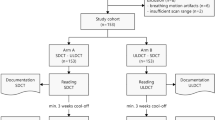Abstract
Background
The increasing use of dual-energy computed tomography (CT) and of reduced kVp protocols exposes the marked energy dependence of the Hounsfield unit (HU) as a measure of X-ray attenuation. This dependence of HU on energy limits its use as a quantitative diagnostic parameter, potentially leading to inaccurate diagnoses.
Purpose
To describe a method for annotating the HU using superscripts and subscripts that inform the observer of the origin of the unit.
Methods
First, we review the HU and describe its use and limitations with variable energy CT. Examples of energy dependence and measureable curve effects are then discussed. The significance of HU value variation and its effects on diagnostic criteria will be presented. Improved annotation based on superscript and subscript methods that are derived from international nomenclature guidelines is proposed.
Conclusion
The increasing use of variable energy CT allows for improved diagnostic techniques, and reduced radiation exposure, but at the expense of increasing the complexity of interpreting the meaning of HU values in various diagnostic contexts. A method for precise HU description is presented, streamlining diagnostic criteria.




Similar content being viewed by others
References
Hounsfield GN (1973) Computerized transverse axial scanning (tomography). 1. Description of system. Br J Radiol 46(552):1016–1022
Hounsfield GN (1980) Nobel Award address. Computed medical imaging. Med Phys 7(4):283–290
Bolus DN (2013) Dual-energy computed tomographic scanners: principles, comparisons, and contrasts. J Comput Assist Tomogr 37(6):944–947
Siegel MJ, et al. (2016) White Paper of the Society of Computed Body Tomography and Magnetic Resonance on Dual-Energy CT, Part 1: technology and terminology. J Comput Assist Tomogr 40(6):841–845
Hubbell JH, Seltzer SM (1995) Tables of X-ray mass attenuation coefficients and mass energy-absorption coefficients 1 keV to 20 MeV for elements Z = 1 to 92 and 48 additional substances of dosimetric interest. Published 1 Jan 1995. https://www.nist.gov/pml/x-ray-mass-attenuation-coefficients#. Accessed 07 Dec 2016
Levi C, et al. (1982) The unreliability of CT numbers as absolute values. Am J Roentgenol 139(3):443–447
Lamba R, et al. (2014) CT Hounsfield numbers of soft tissues on unenhanced abdominal CT scans: variability between two different manufacturers’ MDCT scanners. Am J Roentgenol 203(5):1013–1020
http://unitsofmeasure.org. Accessed 07 Dec 2016
http://www.nlm.nih.gov/research/umls/. Accessed 07 Dec 2016
Health Level Seven Reference Implementation Model, V3
Thompson A, Taylor BN (2008) NIST special publication 811 2008 edition. http://physics.nist.gov/cuu/pdf/sp811.pdf. Accessed 07 Dec 2016
The NIST reference on constants, units and uncertainty. http://physics.nist.gov/cuu/index.html. Accessed 07 Dec 2016
Author information
Authors and Affiliations
Corresponding author
Ethics declarations
Funding
No funding was received related to the work or preparation of this manuscript.
Conflict of interest
The authors declare that they have no conflict of interest.
Ethical approval
For this type of study formal consent is not required. This article does not contain any studies with human participants performed by any of the authors.
Informed consent
Statement of informed consent was not applicable since the manuscript does not contain any patient data.
Rights and permissions
About this article
Cite this article
Bolus, D., Morgan, D. & Berland, L. Effective use of the Hounsfield unit in the age of variable energy CT. Abdom Radiol 42, 766–771 (2017). https://doi.org/10.1007/s00261-017-1052-4
Published:
Issue Date:
DOI: https://doi.org/10.1007/s00261-017-1052-4




